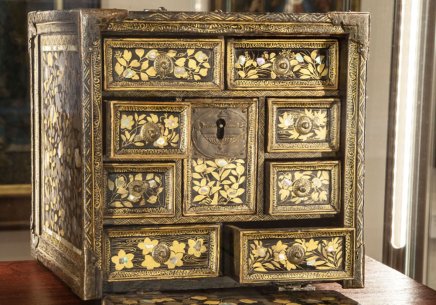
A presentation held at the EUROPEUM – Centre for European Culture shows artworks that, though not created in Europe, were influenced by European art. A cabinet and tsuba sword guards representing the namban art reflect this influence which was typical of this style of Japanese art. It developed at the turn of the 16th and 17th centuries, and this is the period the objects in the collection of the National Museum in Krakow date back to.
The forms of these items and their rich ornamentation serve as characteristic examples of the namban style. This term, which literally translates as southern barbarians, referred to the Europeans who arrived in Japan in the 16th century (Portuguese traders arrived in Japan in 1543), as well as the inhabitants of Continental Asia. Both the Europeans and Asians – merchants, travellers and missionaries – penetrated deep into Japan from its southern seaports. Therefore, this clearly contemptuous name referring to foreigners contained an element indicating the direction.
However, despite their unconcealed aversion to strangers, Japanese people watched the objects brought by them with curiosity. They were astonished, for example, by oil paintings – both their technique, which had not been seen in Japan before, and their subject matter. Frequently incomprehensible, the latter
sometimes led to anecdotal situations – as in the case when some women who visited one ship captain fell to their knees to honour a portrait of a woman which decorated the interior, believing that it showed the Virgin Mary. In fact it was a sensual image of Venus that helped sailors while away the time spent on the ship...
Objects of decorative arts intrigued with their shapes which revealed their unusual functions. This category included, among other things, some pieces of furniture, whose completely different forms resulted from the application in a very differently arranged living space in Europe. Thanks to unknown utensils from overseas countries, such as optical instruments, the Japanese became more familiar with the customs and technical achievements of the West.
It did not take long for this interest in novelties to bring effects in the form of curious shapes, motifs and art techniques. Most often these were the outcomes of traditional Japanese handicraft and experience gained through the contact with the Western world. It was a source of inspiration for decorative motifs
assimilated and transformed according to the taste of the public. The fascination with not only elaborate ornaments decorating surfaces of objects brought by foreigners but also exotic plants and animals contributed to the popularity of certain motifs, for example foliated scrolls densely covering the surface of artworks. Japanese attachment to empty spaces, unspoken meanings and reduced forms gave way to a new tendency towards filling the entire surface of an artwork with detail, where the horror vacui principle forced artists to enrich foliated scrolls with silhouettes, often inspired by the patterns of the flora and fauna of the West. A significant role in popularizing these tendencies was played by Europeans’ interest in exotic subjects and techniques. Merchants received special commissions from European magnates who were fascinated by the uniqueness of lacquer objects sprayed with gold or silver.
Due to an important part played by missionaries in establishing contacts between cultures, the period of the widespread popularity of these tendencies coincided with the process of propagating Christianity in Japan. As a result, it is possible to date the namban artworks fairly precisely. Actually, from the moment of the increased fascination with Christianity, that is around 1590, to the introduction of a blanket ban on practising this religion in Japan in 1624 no more than four decades passed.
An example that perfectly illustrates the above tendencies was a cabinet on display – a small sized piece of furniture with a movable side, behind which there are nine drawers arranged in four horizontal rows. One of them, in the very centre, was locked with a key – added together with the fitting in the 18th century in Europe. The surface of outer walls of the cabinet and the faces of drawers are covered with different motifs of foliated scrolls. Among tangled peony branches, scrolls of ivy, maple leaves and sour cherry flowers one can see stylized silhouettes of birds and long-horned antelopes. An impression of elaborate ornamentation is intensified by the encrustation with nacre which, shimmering with colourful reflections, alternates gilding sprayed on lacquer and adds colour to the cabinet with dark, matte bronze fittings.
A guard – tsuba – is a part of a sword regarded as the “samurai’s soul.” The tsuba protected the hand from the blows of the enemy, at the same time contributing to the balance of the weapon. Giving sword guards – important parts of the Japanese sword – forms inspired by decoration typical of overseas art is an evidence that this type of inspiration was highly regarded in Japan. An idea to fill entire surfaces with lavish ornamentation, taken from European culture, adopted a number of intriguing forms and gained general acceptance, as a result of which it was used in armour making until the 18th century, which is exemplified by the tsuba guards on display.
Curator: Beata Romanowicz
Europeum, exhibition, National Museum Krakow, Japan, Krakow, Poland
MNK The Wyspiański
pl. Sikorskiego 6, 31-115 Kraków- Monday: closed
- Tuesday: 10.00-17.00
- Wednesday - Thursday: closed
- Friday - sunday: 10:00 – 17:00